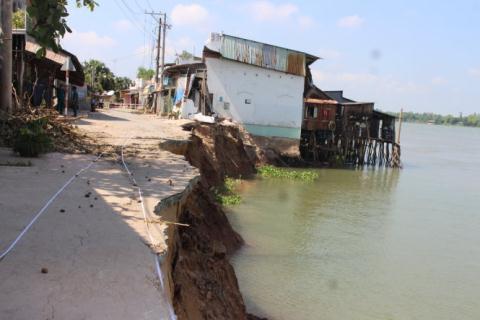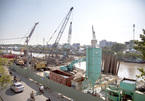Experts have repeatedly expressed their concern about the uncontrolled sand exploitation in Mekong Delta.

This has caused the loss of sand in the lower course, the lowering of river bed and changes to the current, thus aggravating the problems that Mekong area faces, especially landslide and subsidence.
According to Dinh Cong San from the Southern Institute of Water Resources, in 2010-2013, the institute implemented a scientific research project on studying the impact of the sand exploitation activities on the currents of Tien and Hau Rivers (the two tributaries of Mekong).
| The World Wildlife Fund (WWF) and Mekong River Commission (MRC) say the river bed of Mekong’s two main tributaries in Mekong Delta fell by 1.4 meters in 1998-2008 due to sand overexploitation. |
The research team counted all the licenses for sand mining on Tien and Hau Rivers granted by the local departments of science and technology, natural resources and the environment, and construction to sand mining enterprises. The total volume of sand was up to 28 million cubic meters a year.
“We calculated the volume of sand reaching the Mekong Delta and the volume of sand exploited within a year to find out if the overexploitation exists,” San explained.
28 million cubic meters were just the figure shown in licenses. Meanwhile, the real volume of sand exploited must be higher.
Some provinces could see the harmful impacts of the sand exploitation and stopped licensing the exploitation. Can Tho was one.
The scientists found that only several million cubic meters of sand flowed to Mekong Delta a year, which is much lower than the volume of sand exploited,” San said.
The expert affirmed that each river section needs to have stable depth. In case the depth changes because of the sand overexploitation, this will cause a threat to the river section and other areas.
While the volume of sand and sludge from the upper course is on the decrease because of the appearance of hydropower dams, the volume of sand taken away in the lower course is on the rise because of the increasingly high demand for sand for infrastructure and construction works.
Vietnam prohibits exporting sand, but illegal export continues. It is still unclear the level of illegal exports. San believes this is not a big figure.
Some years ago, some scientific research works found that the volume of sand flowing to the lower course now is just 40-50 percent of the volume in the past. It is estimated that the volume of sand would drop by up to 80-90 percent if more hydropower dams and reservoirs are built in the upper course.
Thanh Mai

Mekong Delta takes measures to cope with saltwater intrusion
Saltwater intrusion has occurred on a large scale in the Mekong Delta, forcing local authorities to take measures to protect agricultural production and ensure water supply for household use.

Mekong Delta farmers expect good harvest of Tet flowers
Farmers in the Cuu Long (Mekong) Delta region are expected to have a good flower and ornamental plant harvest, as well as good prices, for the Tet (Lunar New Year) festival, which falls on January 25.
 The World Wildlife Fund (WWF) and Mekong River Commission (MRC) say the river bed of Mekong’s two main tributaries in Mekong Delta fell by 1.4 meters in 1998-2008 due to sand overexploitation.
The World Wildlife Fund (WWF) and Mekong River Commission (MRC) say the river bed of Mekong’s two main tributaries in Mekong Delta fell by 1.4 meters in 1998-2008 due to sand overexploitation.